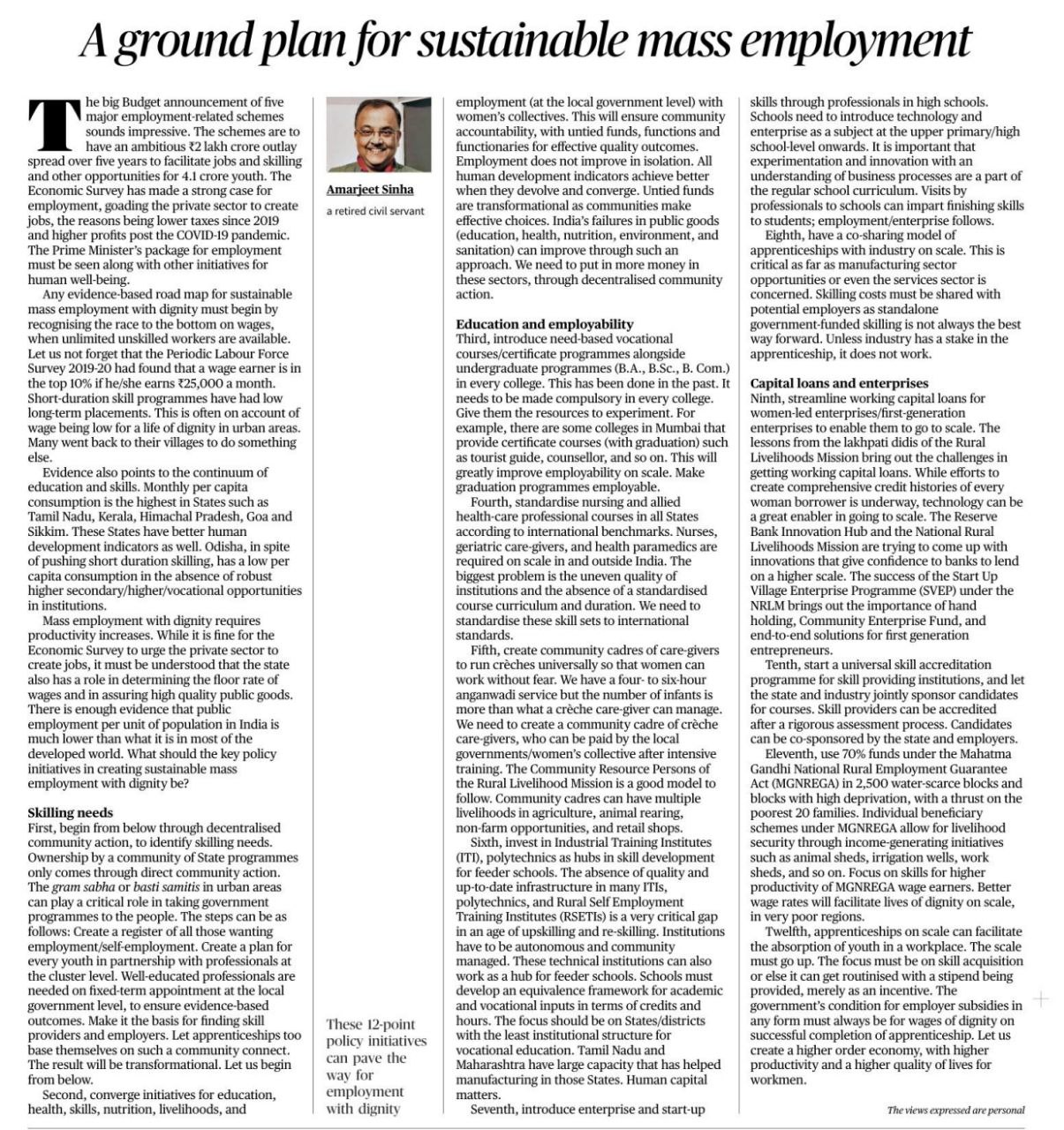1. Sustainable Mass Employment : Needs and Solutions
Introduction
India’s budget allocates ₹2 lakh crore over five years for job creation and skill development for 4.1 crore youth. Despite this, achieving sustainable, dignified employment requires addressing systemic issues beyond financial allocations.
- Wage and Employment Dignity:
- Current Data: The Periodic Labour Force Survey 2019-20 reveals that earning ₹25,000 a month is in the top 10% of wage earners. Low wages from short-term skills programs force many to return to rural jobs.
- Solution: Set and enforce minimum wage standards to ensure dignified living conditions in urban areas.
- Human Development Integration:
- State Evidence: States like Tamil Nadu and Kerala, with high per capita consumption and human development indicators, show that integrating education, health, and skills improves employment outcomes. Odisha’s low per capita consumption despite short-term skilling highlights this need.
- Solution: Converge education, health, skills, and nutrition initiatives at the local government level, using community-based approaches.
- Enhancing Education and Employability:
- Vocational Training: Make vocational courses mandatory alongside undergraduate programs in colleges. Example: Mumbai colleges offering certificates with graduation.
- Standardization: Standardize nursing and allied health courses to international benchmarks.
- Community Crèches: Create community cadres for crèches to support working women.
- Strengthening Technical Education:
- ITIs and Polytechnics: Invest in and modernize Industrial Training Institutes (ITIs) and polytechnics. Ensure they are community-managed and linked to feeder schools.
- Fostering Entrepreneurship and Skill Development:
- Enterprise Skills: Incorporate technology and enterprise education in schools.
- Apprenticeships: Develop industry co-sharing models for apprenticeships to ensure relevance and employer involvement.
- Financial Support and Accreditation:
- Capital Loans: Streamline loans for women-led and first-generation enterprises. Use technology to facilitate credit access.
- Skill Accreditation: Establish universal skill accreditation with state and industry sponsorship.
- Leveraging Existing Programs:
- MGNREGA: Use 70% of MGNREGA funds in high-deprivation areas for income-generating projects and skill enhancement.
- Scaling Apprenticeships:
- Scale and Quality: Expand apprenticeships with a focus on skill acquisition and dignified wages upon completion.
Conclusion
Achieving sustainable mass employment with dignity requires more than budgetary measures. Effective integration of wages, education, skills, and community involvement is crucial. Coordinated efforts across government, industry, and communities are necessary to create a robust employment ecosystem.
Mains Practice Question:
|
Discuss the key challenges and policy initiatives required to achieve sustainable mass employment with dignity in India. How can the integration of education, skill development, and community involvement contribute to this goal?
|
2. Unemployment a problem to be dealt with
Creating Employment in the Long Run
Introduction
The annual Budget often features grand announcements which, unfortunately, lack follow-through. The recent Budget’s focus on employment schemes, including a controversial internship program, highlights the gap between promises and implementation. A strategic, long-term investment plan is needed to address the persistent employment crisis.
- Issues with Current Employment Schemes:
- Scheme Design Flaws: The Finance Minister announced a five-scheme package aiming to create 1 crore internships over five years, targeting only the top 500 companies. This excludes micro, small, and medium enterprises, and is logistically unfeasible as most companies do not employ 4,000 people, let alone interns.
- Non-Mandatory Nature: The scheme was later clarified as a non-mandatory nudge, contrasting with comprehensive plans like the Congress’s Right to Apprenticeship, which aimed at a broader, operationalized approach.
- Critique of Supply-Side Measures:
- Mismatch of Measures: Government measures focus on financing recruitment but ignore the demand side of the job market. Without increased demand and production capacity, companies are unlikely to expand their workforce.
- Historical Failures: Past initiatives like the Atmanirbhar Bharat package similarly relied on supply-side measures, which did not address the underlying issues of low demand.
- Current Employment Data and Trends:
- Discrepancies in Data: The RBI’s claim of 109 million new jobs between 2019-20 and 2023-24 is questioned due to methodological limitations and discrepancies with the Periodic Labour Force Survey (PLFS), which shows only a 4% increase in the labor force participation rate.
- Agricultural and Self-Employment Trends: A large portion of job creation is in agriculture and self-employment due to a lack of gainful jobs elsewhere. MGNREGA data indicates high rural distress with 24.8 lakh new job card holders in 2024-25 and 5.8 crore people demanding jobs.
- Decline in Manufacturing Jobs:
- Manufacturing Sector Trends: The share of manufacturing jobs declined from 12.6% in 2011-12 to 11.4% in 2022-23. Key industrial sectors like textiles and electronics have seen negative growth.
- Government Job Market Challenges:
- Competitive Exam Pressures: The tragic incident in Delhi underscores the desperation of job seekers facing tough competitive exams for limited government positions.
- Vacancies and Recruitment: Despite 22 crore job applications, only 7.2 lakh government jobs were filled in eight years. There are 30 lakh vacancies in Central government posts, highlighting the need for timely recruitment and tackling corruption.
- Need for a Comprehensive Economic Package:
- Long-Term Investments: Instead of short-term nudges, a comprehensive economic package focusing on long-term investment in essential public services and green jobs is needed. This would improve quality of life, boost workforce productivity, and create sustainable employment opportunities.
Conclusion
The current approach to addressing the employment crisis through short-term schemes and supply-side measures is insufficient. A strategic, long-term investment in public services and green jobs is essential for creating sustainable employment and improving the overall quality of life.
Mains Practice Question:
|
Q. Evaluate the effectiveness of the current employment schemes announced in the recent Budget. How can a comprehensive economic package address the long-term employment challenges in India? Discuss with reference to data and trends in job creation and public sector employment.
|



